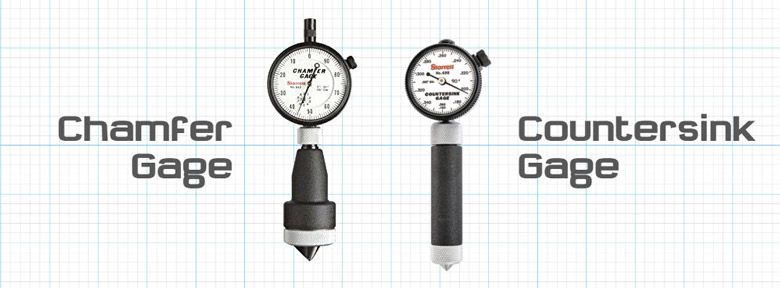Chamfer and countersink gages are very similar in use and appearance. The central difference between these two gages are the holes they are intended to measure. Chamfered and countersunk holes, while also similar in appearance, require different gages with their own unique functional capabilities. Today we are going to go through the differences between chamfer and countersink gages, explaining the advantages and disadvantages of each, and how to know which one is right for your precision measurement job..
Chamfer and Countersink Holes: Differences
Chamfered and countersunk holes are both man-made holes in machines or materials created to insert another part into.
Technically, chamfer refers to an edge that transitions one surface of a part to another. In fact, to complicate matters, a countersink hole can be chamfered. However, in practicality, these two types of holes are distinguished from each other in function, thus resulting in two distinct gages needed for their measurement.
A chamfer hole is created in order to simplify the process of inserting a type of assembly component. This could include:
- bushing
- pin
- screw
- other types
The important fact with a chamfer hole is that whatever assembly component is inserted, this will not bear on the chamfer hole itself. This means that neither the tolerance of the angle or diameter of the hole will determine performance.
Alternatively, a countersink hole functions as a surface onto which a fastener head needs to bear. What this means is that the tolerances of the angle and diameter of a countersink hole are critical to it functioning properly.
Chamfer and Countersink Holes: Similarities
- Both a chamfer gage and a countersink gage are made up of a plunger and a ratio indicator.
- They are each intended to measure the largest diameter of their respective holes, along the top surface of the part.
- Both are generally hand-held, but may also be mounted on bench stands.
- For both a chamfer and a countersink gage, the plunger mechanism is used in a vertical motion to take the measurement, while the indicator uses the ratio movement to relay the proper readout.
The specific build, however, of each gage is unique. The chamfer gage includes a plunger with three fluted portions.
Measuring a range of chamfer holes will either require:
- two gages with a split range (0 to 90 degrees and 90 to 127 degrees)
- or a gage with replaceable plungers to cover the ranges
The angle of the plunger on a chamfer gage is required to be bigger than the angle of the chamfer hole itself. This guarantees that what the plunger comes in contact with in the measurement process is the largest diameter only.
Alternatively, the countersink gage includes a plunger with a conical shape, designed specifically to fit closely to the whole surface of the countersink hole. The angle of the plunger on the countersink gage calls out to a specific angle, the degree:
- 30
- 60
- 82
- 90
- 100
- 110
- 120
This fit is very important in order for the countersink gage to make accurate measurements. When measuring different sized countersink holes, individual gages are necessary because there is no replaceable plunger for these gages.
Advantages and Disadvantages to each Gage
While similar in structure and build, chamfer and countersink gages serve different functions when measuring chamfer and countersink holes. However, there are general advantages and disadvantages to both.
Chamfer Gages
The gages tend to be relatively long and versatile. You are able to master these gages on any good, flat surface. However, chamfer gages require you to count the revolutions on dial models in order to calculate a reading, and the fit is less precise than with a countersink gage. This is because chamfer gages cover a wider range of possible diameters.
Countersink Gages
These gages do not require you to count revolutions because their dial versions are 1 revolution direct read. Additionally, countersink gages provide measurement information concerning both the top inside diameter as well as the angle of the hole, resulting in measurements of both form and diameter.
A few disadvantages of countersink gages include:
- Not being able to master the gage on a flat surface
- Requiring a sharp-edge ring
- Only using countersink gages due to their short range
How Do I Choose The Right Gage Tool forChamfer or Countersink Holes?
In general, both the chamfer and the countersink gage are excellent tools. You can use them interchangeably on occasion, but for specific holes you will need one or the other. Both gages come with advantages and disadvantages, so your best bet if in the field of metrology is to own them both!
Shop our selection of gages:

